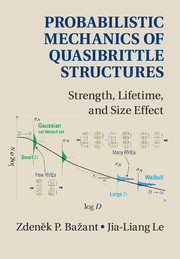Book contents
- Frontmatter
- Dedication
- Contents
- Foreword
- Preface
- 1 Introduction
- 2 Review of Classical Statistical Theory of Structural Strength and Structural Safety, and of Statistics Fundamentals
- 3 Review of Fracture Mechanics and Deterministic Size Effect in Quasibrittle Structures
- 4 Failure Statistics of Nanoscale Structures
- 5 Nano–Macroscale Bridging of Probability Distributions of Static and Fatigue Strengths
- 6 Multiscale Modeling of Fracture Kinetics and Size Effect under Static and Cyclic Fatigue
- 7 Size Effect on Probability Distributions of Strength and Lifetime of Quasibrittle Structures
- 8 Computation of Probability Distributions of Structural Strength and Lifetime
- 9 Indirect Determination of Strength Statistics of Quasibrittle Structures
- 10 Statistical Distribution and Size Effect on Residual Strength after Sustained Load
- 11 Size Effect on Reliability Indices and Safety Factors
- 12 Crack Length Effect on Scaling of Structural Strength and Type 1 to 2 Transition
- 13 Effect of Stress Singularities on Scaling of Structural Strength
- 14 Lifetime of High-k Gate Dielectrics and Analogy with Failure Statistics of Quasibrittle Structures
- Appendix A Power-Law Scaling of Boundary Value Problems
- Appendix B Proof of Transitional Size Effects of Types 1 and 2 by Dimensional Analysis and Asymptotic Matching up to Second Order
- Appendix C Proof of Small-Size Asymptotics of Cohesive Crack Model up to Second Order
- References
- Author Index
- Subject Index
12 - Crack Length Effect on Scaling of Structural Strength and Type 1 to 2 Transition
Published online by Cambridge University Press: 14 June 2017
- Frontmatter
- Dedication
- Contents
- Foreword
- Preface
- 1 Introduction
- 2 Review of Classical Statistical Theory of Structural Strength and Structural Safety, and of Statistics Fundamentals
- 3 Review of Fracture Mechanics and Deterministic Size Effect in Quasibrittle Structures
- 4 Failure Statistics of Nanoscale Structures
- 5 Nano–Macroscale Bridging of Probability Distributions of Static and Fatigue Strengths
- 6 Multiscale Modeling of Fracture Kinetics and Size Effect under Static and Cyclic Fatigue
- 7 Size Effect on Probability Distributions of Strength and Lifetime of Quasibrittle Structures
- 8 Computation of Probability Distributions of Structural Strength and Lifetime
- 9 Indirect Determination of Strength Statistics of Quasibrittle Structures
- 10 Statistical Distribution and Size Effect on Residual Strength after Sustained Load
- 11 Size Effect on Reliability Indices and Safety Factors
- 12 Crack Length Effect on Scaling of Structural Strength and Type 1 to 2 Transition
- 13 Effect of Stress Singularities on Scaling of Structural Strength
- 14 Lifetime of High-k Gate Dielectrics and Analogy with Failure Statistics of Quasibrittle Structures
- Appendix A Power-Law Scaling of Boundary Value Problems
- Appendix B Proof of Transitional Size Effects of Types 1 and 2 by Dimensional Analysis and Asymptotic Matching up to Second Order
- Appendix C Proof of Small-Size Asymptotics of Cohesive Crack Model up to Second Order
- References
- Author Index
- Subject Index
Summary
As already explained in Chapters 1 to 3, there are two basic types of quasibrittle failure and size effect, types 1 and 2. They have different large-size asymptotes of the size effect and different statistical contributions of material randomness. Type 1 (Bažant & Li 1995b; Bažant 1997; Bažant & Novák 2000a, 2000b; Bažant 2005) occurs when the maximum load is attained already at macrocrack initiation, and type 2 (Bažant 1984a; Bažant & Pfeiffer 1987; Bažant & Kazemi 1990a, 1990b; Bažant 2005) occurs when, at maximum load, there is a large notch or a large stress-free (or fatigued) crack (note that in Bažant 2005 Type 1 is called Case 2, and Type 2 Case 1).
If the structure is much larger than the size of the representative volume element (RVE) or, equivalently, the size of the fracture process zone (FPZ), type 1 exhibits a large statistical effect of material randomness on the mean of structural strength, particularly on its coefficient of variation (CoV), while at small sizes the type 1 size effect is essentially deterministic. By contrast, the type 2 size effect on the mean structural strength is essentially deterministic at all sizes, owing to energy release and the associated stress redistribution, while the material randomness affects only the CoV of structural strength.
Progress in the modeling of concrete fracture and introduction of fracture concepts into the design codes and practice has been impeded by the unavailability of a comprehensive database for fracture. The literature features a vast amount of fracture data (e.g., Sabnis & Mirza 1979; Petersson 1981; Nallathambi 1986; Bažant & Pfeiffer 1987; Malvar & Warren 1988; Carpinteri, Chiaia, & Ferro 1995a; Rocco 1995; Tang, Bažant, Yang, & Zollinger 1996; Bažant & Planas 1998; Becq-Giraudon 2000; Bažant & Becq- Giraudon 2002; Karihaloo, Abdalla, & Xiao 2003, Hoover et al. 2013). But all these data except the last cover only rather limited ranges of specimen size, initial notch depth, and post-peak response, and have been performed on different concretes, on different batches of supposedly the same concrete, at different ages, at different environmental conditions, at different rates, with different test procedures, and on specimens of different types and dimensions.
- Type
- Chapter
- Information
- Probabilistic Mechanics of Quasibrittle StructuresStrength, Lifetime, and Size Effect, pp. 210 - 217Publisher: Cambridge University PressPrint publication year: 2017



